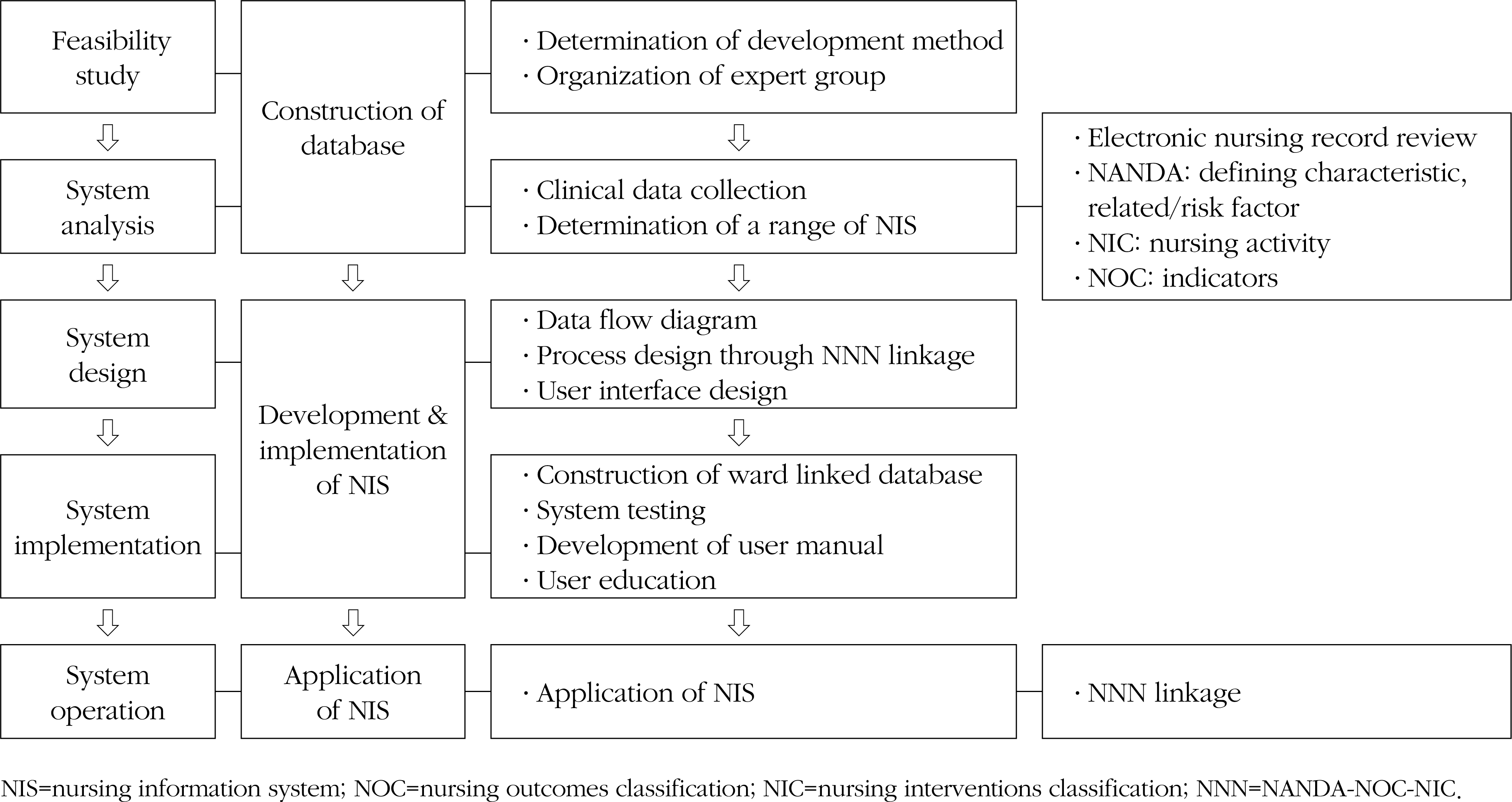Abstract
Purpose
The purpose of this study was to construct, develop, and apply a nursing information system (NIS) using NANDA-NOC-NIC linkage in medical-surgical nursing units.
Methods
This study consisted of three phases which were the construction of the database, development of the NIS, and application of the NIS. To construct the database, a questionnaire and nursing record review by an expert group were used. Collected data were analyzed by the SPSS/WIN 13.0 program.
Results
In first phase, the database was made up of 50 nursing diagnoses, 127 nursing outcomes and 300 nursing interventions. In the second phase, NIS was developed according to its flow diagram and then tested. In the third phase, the developed NIS was applied to 130 inpatients. Nursing diagnoses frequently used were acute pain, delayed surgical recovery, and deficient knowledge (specify). Nursing outcomes for a nursing diagnosis of 'acute pain' were identified as pain control, pain level and comfort level. Nursing interventions for the nursing outcome 'pain control' were pain management, patient controlled analgesia assistance and medication management.
REFERENCES
Beyea S. C.2003. Describing professional nursing through a universal record in perioperative settings. International Journal of Nursing Knowledge. 14(s4):23.

Bulechek G.., Butcher H.., Dochterman J. M.2007. Nursing interventions classification (NIC). 5th ed.St Louis: Mosby.
Cho E. J.., Kim N. C.2008. Validation of major nursing diagnosis-outcome-intervention (NANDA-NOC-NIC) linkage for adult surgery patients of post anesthetic care unit. Journal of Korean Clinical Nursing Research. 14(3):141–151.
Choi S. H.., Choi B. H.., Ji H. R.., Lee E. J.., Kim H. S.., Park M. J.2006. Standardized NANDA, NOC, NIC linkage. Seoul: Hyunmoon.
Fehring R. J.1986. Validation diagnostic labels: Standardized methodology. St Louis: Mosby.
Hughes R.2003. The use of NANDA, NIC, and NOC in the identification and measurement of problems, interventions, and outcomes in spinal cord injury. International Journal of Nursing Knowledge. 14(s4):18–19.

Ji M. K.., Ji S. A.2003. Linkages of nursing diagnoses, nursing intervention, and nursing outcome classification of brest cancer patients using nursing database. Journal of Korean Academy of Nursing Administration. 9:651–661.
Johnson M.., Bulechek G.., Dochterman J. M.., Maas M.., Moorhead S.., Swanson E., et al. 2005. NANDA, NOC, and NIC linkages: Nursing diagnoses, outcomes, & interventions. 2nd ed.St. Louis: Mosby.
Johnsons M.., Mass M.., Moorhead M.2000. Nursing Outcomes Classifications. 2nd ed.St. Louis: Mosby.
Jung K. I.2003. Development of the ICNP based cancer nursing information system. Journal of Korean Society of Medical Informatics. 9(1):21–24.
Killeen M. B.2003. Comfort management as a proposed NIC, and validation of three NOCs for end-of-life and chronically ill patients. International Journal of Nursing Knowledge. 14(Supplement 4):19.
Kim H. S.2005. Development and application of a computerized nursing process program for orthopedic surgery inpatients-NANDA, NOC, and NIC linkage. Journal of Korean Academy of Nursing. 35:979–990.
Kim J. K.2010. A study on nursing diagnoses, interventions, outcomes frequently used and linkage to NANDA-NOC-NIC in major nursing departments. Journal of Korean Academy of Nursing Administration. 16:121–142.

Kim M. J.2010. Analysis on military hospital nursing records by NANDA, NIC, NOC system. Journal of Korean Academy of Nursing Administration. 16:73–85.

Kim P. J.2006. Application model of the nursing process to electric medical records for cardiodiovascular patients. Unpublished doctoral dissertation, Yonsei University, Seoul.
Lee E. J.., Choi S. H.2011. Identification of nursing diagnosis-outcome-intervention(NANDA-NOC-NIC) linkage in surgical nursing unit. Korean Journal of Adult Nursing. 23:180–188.
Lee E. J.., Park H. J.2003. Development and application of the computerized nursing process program using nursing diagnoses-outcome-intervention linkage. Journal of Korean Society of Medical Informatics. 9(Suppl 1):107.
Lippens B.2003. Use of NANDA, NIC, and NOC in infection control. International Journal of Nursing Knowledge. 14(Suppl 4):20.

Lunney M.., Delaney C.., Duffy M.., Moorhead S.., Welton J.2005. Advocating for standardized nursing languages in electronic health records. Journal of Nursing Administration. 35(1):1–3.

Manning J.., McConnell E. A.1997. Technology assessment: A framework for generation questions useful in evaluation nursing information systems. Computers in Nursing. 15(3):141–146.
North American Nursing Diagnosis Association. 2007. Nursing diagnoses: Definitions & classification 2007-2008. Philadelphia: NANDA International.
Park J. E.., Chung K. A.., Cho H.., Kim H. S.2013. Construction of the nursing diagnosis ontology in obstetric and gynecologic nursing unit using nursing process and SNOMED CT. Korean Journal of Women Health Nursing. 19(1):1–12. http://dx.doi.org/10.4069/kjwhn.2013.19.1.1.

Park M. J.2010. Identification of nursing diagnosis-outcome-intervention (NANDA-NOC-NIC) linkage in MICU inpatients. Unpublished doctoral dissertation, Chonnam National University, Gwangju.
Park S. H.2006. Linkages of nursing diagnoses and nursing interventions for clinical decision support system. Unpublished doctoral dissertation, Seoul National University, Seoul.
Scroggins L. M.2008. The developmental processes for NANDA international nursing diagnoses. International Journal of Nursing Knowledge. 19:57–64. http://dx.doi.org/10.1111/j.1744-618X.2008.00082,x.

Shever L. L.., Titler M.., Dochterman J.., Fei Q.., Picone D. M.2007. Patterns of nursing intervention use across 6 days of acute care hospitalization for three older patient populations. International Journal of Nursing Knowledge. 18:18–29.

Yom Y. H.., Chi S. A.., Yoo H. S.2002. Application of nursing diagnoses, interventions and outcomes to patients undergoing abdominal surgery in Korea. International Journal of Nursing Knowledge. 13:77–87.

Yoo H. S.., Chi S. A.2001. Construction of linkage database on nursing diagnoses, interventions, outcomes in abdominal surgery patients. Journal of Korean Academy of Nursing Administration. 7:425–439.
Figure 1.
Research procedure for the development of the nursing information system by system development life cycle.

Table 1.
Nursing Diagnoses for Database Construction (N=72)
Table 2.
General Characteristics of the Inpatients used in the Nursing Information System (N=130)
Table 3.
NANDA-NOC-NIC Linkage used in the Nursing Information System: Acute Pain




 PDF
PDF ePub
ePub Citation
Citation Print
Print



 XML Download
XML Download